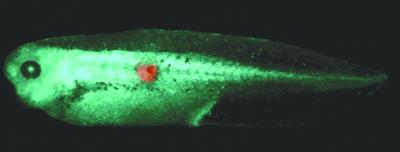Biologists have discovered a bioelectric signal that can identify cells that are likely to develop into tumors. The researchers also found that they could lower the incidence of cancerous cells by manipulating the electrical charge across cells' membranes.
Bioelectric signals underlie an important set of control mechanisms that regulate how cells grow and multiply. The study investigated the bioelectric properties of cells that develop into tumors in Xenopus laevis frog embryos.
In previous research, it was found that manipulating membrane voltage can influence or regulate cellular behavior such as cell proliferation, migration, and shape in vivo, and be used to induce the formation or regenerative repair of whole organs and appendages. In the study, the researchers hypothesized that cancer can occur when bioelectric signaling networks are perturbed and cells stop attending to the patterning cues that orchestrate their normal development.

This shows a tumor within a tadpole embryo that has been labeled with red fluorescence to allow tracking. Credit: Brook Chernet; Tufts University School of Arts and Sciences
The researchers induced tumor growth in the frog embryos by injecting the samples with mRNAs (messenger RNA) encoding well-recognized human oncogenes Gli1, KrasG12D, and Xrel3. The embryos developed tumor-like growths that are associated with human cancers such as melanoma, leukemia, lung cancer, and rhabdomyosarcoma (a soft tissue cancer that most often affects children).
When the researchers analyzed the tumor cells using a membrane voltage-sensitive dye and fluorescence microscopy, they made an exciting discovery.
"The news here is that we've established a bioelectric basis for the early detection of cancer," says Brook Chernet, doctoral student and first author of the paper from Tufts University. "The tumor sites had unique depolarized membrane voltage relative to surrounding tissue. They could be recognized by this distinctive bioelectric signal."
"We've shown that electric events tell the cells what to do. The voltage changes are not merely a sign of cancer. They control and direct whether the cancer occurs or not," said Michael Levin, Ph.D., professor of biology and director of the Center for Regenerative and Developmental Biology at Tufts.
Changing Electrical Properties Lowers Incidence of Tumors
They were also able to show that changing the bioelectric code to hyperpolarize tumor cells suppressed abnormal cell growth. "We hypothesized that the appearance of oncogene-induced tumors can be inhibited by alteration of membrane voltage," says Levin, "and we were right."
To counteract the tumor-inducing depolarization, they injected the cells with mRNA encoding carefully-chosen ion channels (proteins that control the passage of ions across cell membranes).
Using embryos injected with oncogenes such as Xrel3, the researchers introduced one of two ion channels (the glycine gated chloride channel GlyR-F99A or the potassium channel Kir4.1) known to hyperpolarize membrane voltage gradients in frog embryos. In both cases, the incidence of subsequent tumors was substantially lower than it was with embryos that received the oncogene but no hyperpolarizing channel treatment.
Experiments to determine the cellular mechanism that allows hyperpolarization to inhibit tumor formation showed that transport of butyrate, a known tumor suppressor, was responsible
Published in Disease Models and Mechanisms




Comments